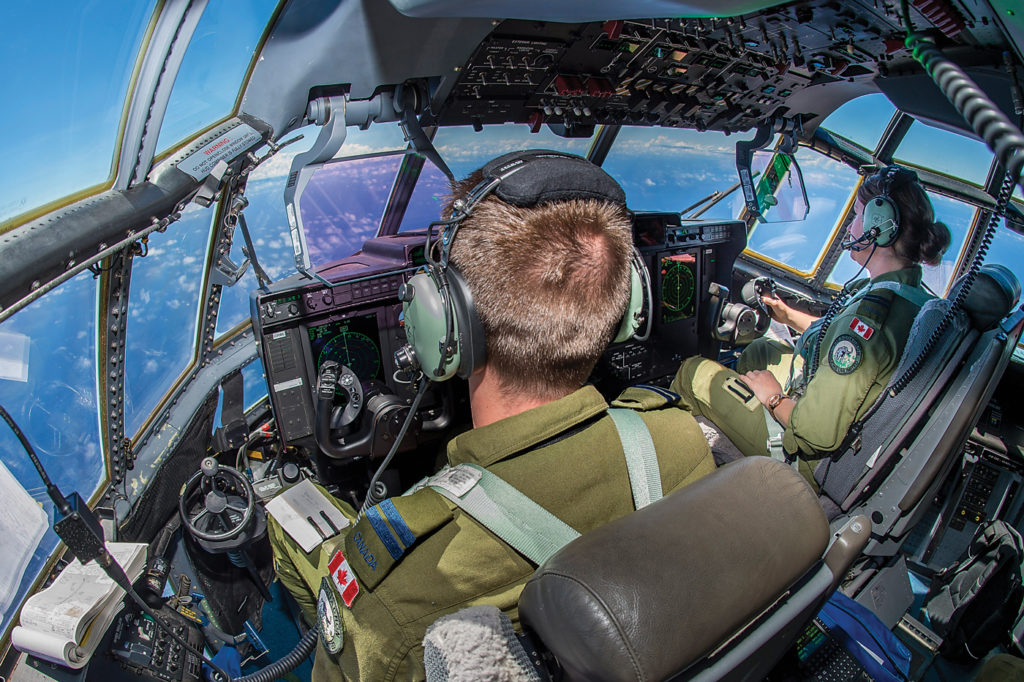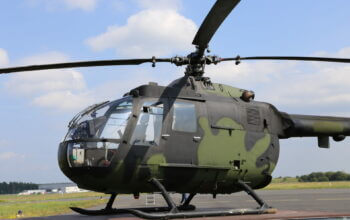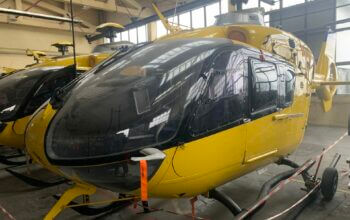Estimated reading time 13 minutes, 41 seconds.
Two years into a series of initiatives to reduce a pilot shortage and retain experience on its frontline squadrons, the Royal Canadian Air Force (RCAF) is on a much less turbulent vector.
Over the past 12 months, the RCAF has cut its shortage of pilots from 203 at the end of 2019, to 145 as of December 2020 – it was facing a shortfall of as many as 275 in 2018.

The improved numbers can be attributed in part to the creation of a new occupation, air operations officer. Air planning, air management and combined airspace operations functions that would previously have been performed by pilots, air combat systems officers, aerospace control officers, or other trades such as communication electronics engineering officers, will now be assumed by specialized personnel.
“The aim is to keep a skilled pilot in a flying role,” said Col Mark Larsen, director of air personnel strategy. “Some of the mission management type roles in the past were done by pilots on a ground tour. We have shifted 69 pilot positions over to the air ops officer occupation, and that has helped bring the establishment requirement down.”
In total, the RCAF has established 190 air ops officer positions across Combined and Wing operations centers, squadrons and other units. The first 18 will be filled this month as officers identified with the necessary skillset transfer over. A further 43 prospective candidates, many from non-commissioned member (NCM) commissioning programs, are receiving additional training and will step into the occupation in the next months.
The Air Force plans to conduct its first air ops officer course in the fall to train candidates for the remaining 129 positions.
The decrease in a pilot shortage is also the result of a Canadian Armed Forces-wide effort under a multi-prong program called Operation Experience to encourage members considering release from service to remain, and recently retired members to re-join. In the past 10 months, eight pilots have re-enrolled and one transferred into the RCAF from an allied nation.
The outcome of a concerted campaign to attract back former skilled members will be more evident in the next months, Larsen added. Retired members who first made contact last spring when the effects of the pandemic began rippling through the economy are just starting to re-enter the RCAF workforce after undergoing enrolment activities such as skills verification and medical assessments. Since April 2020, 19 NCMs in various air maintenance trades have rejoined. “There are still a number of active files that we are working with,” he said.
Other initiatives to keep experience on frontline squadrons have included more contracted instructor pilots – seven new instructors are now at 3 Canadian Forces Flying Training School in Portage la Prairie, Manitoba, allowing experienced pilots to remain on line squadrons.
Under a program to retain talent, the RCAF has also successfully encouraged pilots and other aircrew and maintainers to transfer to the Reserve rather than seek outright release. The move leaves the door open for a member to return to the Regular Force if employment conditions in the civil sector change. Since October, the Air Force has seen a net gain of 14 Reserve pilots. While three released, six transferred directly from the Regular Force and eight were moved from the Supplementary Reserve. Significantly, three were skilled re-enrollees who had left the military and then re-joined the Reserve.
Perhaps because of COVID-19 and widespread furloughs and layoffs in civil aviation, the RCAF is estimating its normal annual attrition to decrease by around 10 percent.

While the improving numbers signal a turn in what had been a worrying decline in available pilots, the change is tempered somewhat by Air Force expansion of its occupation requirements, including aircrew and maintainers, as the RCAF prepares for emerging capabilities such as the next-generation fighter jet, remotely-piloted aircraft systems (RPAS), and space programs. On April 1, for instance, the Air Force will add 18 pilot positions to its establishment.
“We need to lead-turn the people to have a bigger workforce at the point in time when equipment starts to arrive,” said Larsen. “We started the last two years with future fighter expansion to prepare the maintenance community. We will see another increase in establishment in April for future fighter, RPAS, and space.”
DYNAMIC PIPELINE
The RCAF is still assessing the impact of the pandemic. Much of the training system was put on pause for about four months between March and July, including basic training programs. The Air Force had decreased the number of people on the basic training list (BTL) in 2020 to 740 to manage delays as pilot candidates transitioned through the various phases of flight training, and to reduce the backlog at the operational training units (OTUs) where they acquire aircraft type training before transitioning to operation squadrons.
The BTL, a seven-year pipeline, has been adjusted up and down throughout the pandemic, and now sits at 730 — a figure that includes almost 300 pilot candidates currently enrolled at the Royal Military College or in other three- to four-year university programs.
The personnel production pipeline, from the recruiting centers to the air crew selection center, aircrew medical testing, and basic training have all been adapted to the constraints of COVID. Recruiting centers have gone digital where possible, decreasing in-person interviews. And the aircrew selection center has adopted health measures and cut the number of candidates being tested at any one time by about half. Provincial isolation requirements have also limited the movement of candidates.
“[COVID] has had an impact on everything, to which we have slowed our system,” said Larsen. “Our primary goal had been to manage our intake to ensure that we flow the training system and not set a false expectation where somebody would come in and have a really long wait time in order to get training.”
Ironically perhaps, because OTUs maintained a steady operating tempo despite the pandemic, many have been able to improve their throughput. “We’ve actually had success in producing aircrew out of that phase of the pilot training,” Larsen acknowledged. Tactical aviation remains one of the few communities still addressing longer wait times in its OTUs.
To move more pilots through faster, the Air Force has prioritized the intake of “semi-skilled” candidates with a pilot’s license or basic flying experience to advance to Phase 2 of the training program. “The pilot entry training authority in 2 Canadian Air Division would determine if they don’t have to do Phase 1 – everybody meets the standard, but we have been able to select those people for a more immediate intake in order to fill the pipe down the road,” explained Larsen.

Under an agreement with Transport Canada, the RCAF is using the department’s instructors and aircraft to alleviate some of the backlog on multi-engine training. In 2020, six pilots obtained multi-engine basic qualification via that route.
The Air Force is also capitalizing on opportunities with allies. Two maritime helicopter pilots are completing training with the New Zealand Air Force, and will return as Phase 3 maritime helicopter qualified before undergoing conversion training on the CH-148 Cyclone. And to increase its number of fighter pilots before the CF-188 Hornet replacement is delivered, the Air Force is adding an instructor in return for a few more student slots at the Euro-NATO Joint Jet Pilot Training Program, fighter pilot lead-in training conducted by the 80th Flying Training Wing at Sheppard Air Force Base, Texas.
“We’ve just finished our annual military occupational review, so [we] will have a much better picture in the coming months,” said Larsen. “If we find that we are producing more individuals and we have some capacity to do more Phase 1 flying training starts, at the appropriate time I can turn up the dial on direct entry recruiting, and we can take more individuals that are coming through the recruiting center door to address that emerging training opportunity.”
By most analyst estimates, a return to normal for civil aviation is still several years away. Nonetheless, the Air Force is “mindful” of what could happen as the sector recovers. The RCAF will strive to keep its retention programs as effective as possible, he said. “We don’t want to see high attrition coming because industry is recovering in a couple of years and they’re looking for individuals.”
To attract young talent directly into the Reserve, for instance, the RCAF has created an air operations support technician occupation. The hope is that some may see it as a worthwhile part-time trade, while others will use it as a stepping stone into the Regular Force. Though such initiatives can generate complexity, maintaining flexibility in the workforce is key to retention, he said.
Many pilots, for example, have been more interested in re-enrolling with the Reserve than the Regular Force. “I think that’s because they’re looking for the flexibility. If they re-enroll in the Regular Force, there’s terms of service they would sign for a number of years. On the Reserve side, they can go to Class A part-time status and [return] to industry if that’s where they came from. I don’t have hard evidence to demonstrate that, but I suspect that we have more officer interest in the Reserve because of that.”









Clearly this is a result of Op Experience rather than the burning trash fire happening in the civilian sector.
Now, now. The total collapse of the civilian aviation sector has nothing to do with the RCAF solving its pilot retention problem.
Perhaps some of the increase can be attributed to the downturn in the civil job market which staunched the mass exodus of CF pilots and even returned some to CF cockpits?
So, let me get this straight: in the worst slump of civil aviation since the beginning of manned flight, the RCAF is congratulating itself for re-enrolling eight pilots? Eight?!? This is quite telling of the disconnect between the upper echelons of the military and the overworked, under compensated line pilots.
The “programs” are not working at all and there is zero oversight on Unit Commanding Officers to ensure they are trying to accommodate reg force pilots in order for them to stay in the reg force. The only reason the trade has recovered temporarily is the airline industry downturn. In 5 years they’ll be back to the same retention issues. The bottom line is that until there are concrete policies allowing for members to elect for geographic stability, less secondary duties, and pay rates comparable to the airlines, they will continue to lose pilots.
Its interesting that the RCAF thinks they have several years. They have at most 6 months, maybe to the end of 2021 to get their programs fully in force or its going to be a story of the horses have already left the barn (as history repeats itself again. and again, and again …..) Once the populace is vaccinated, air travel is going to come roaring back. The shortage in the industry has only been delayed. There were even programs for RCAF helicopter pilots to transition to the right seat at Encore pre pandemic. Jazz and Sky Regional(now gone) also had similar programs. The clock is ticking.
They’re having trouble recruiting pilots, yet that position isn’t actually offered on their application website because (and I quote) “it is not an in demand occupation”. If they’re having trouble getting pilots I am more than willing to become one for them, and I’m sure there are many others. They just gotta let us enlist.
The main issue with the Pilot shortage in Canada is that Transport Canada takes forever to process medicals.
My son is a certified FAA pilot and came back to Canada to complete his courses. He went for his medical in early July and it is now 2 months later. When he started his training in the US, it took 2 weeks to process his medical certification. What gives??? We have capable potential pilots in Canada but the system processes needs to be reviewed.
He is a FAA Commercial pilot and CFI 1 Instructor.
Correction early June not July as stated above.